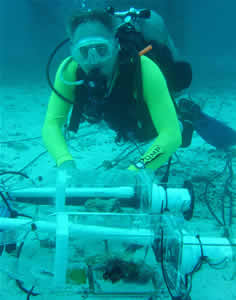 The WeatherBird II is part of a project aimed at encouraging plankton growth. (Credit: Jay Paul for The New York Times)
The WeatherBird II is part of a project aimed at encouraging plankton growth. (Credit: Jay Paul for The New York Times)The WeatherBird II, a 115-foot private research vessel, has put to sea from Florida as part of a novel and contentious effort to commercialize the removal of heat-trapping carbon dioxide from the atmosphere by triggering blooms of plankton.
The ship is operated by Planktos, one of a host of companies involved with the fast-growing global market in “carbon offsets,” credits bought by individuals or companies seeking to compensate for carbon dioxide emissions from flying, electricity use or other energy-intensive activities.
The WeatherBird II entered international waters on Sunday, said Russ George, the chief executive of Planktos, based in Foster City, Calif.
Plankton blooms happen naturally when dust containing iron settles on ocean waters where a lack of iron otherwise prevents plankton from thriving. But efforts to replicate the process artificially have met with strong opposition from some environmental groups.
These include the Sea Shepherd Conservation Society, which for years has confronted, and sometimes rammed, whaling and fishing vessels. It had also planned to try to block a fertilization effort by Planktos this summer near the Galapagos Islands, but the company delayed that project for a variety of reasons, officials said.
Ocean fertilization is one strategy scientists are mulling to blunt the unrelenting growth in carbon dioxide emissions from smokestacks, tailpipes and deforestation.
 A natural phytoplankton bloom in the Bering Sea. (Credit: NASA)
A natural phytoplankton bloom in the Bering Sea. (Credit: NASA)Some scientists have estimated that hundreds of millions of tons of carbon dioxide might be absorbed by fertilized seas, particularly in regions low in iron.
But others say much more research should be conducted before commercial-scale operations begin. Among various questions, scientists have yet to determine how much of the carbon captured by plankton blooms through photosynthesis sinks to the seabed and how much is re-emitted to the atmosphere as carbon dioxide or other greenhouse gases.
This year, the president of Friends of the Earth, Brent Blackwelder, issued a statement saying, “Planktos is selling the equivalent of global warming snake oil.”
In an e-mail exchange Tuesday night, Mr. George declined to discuss the route of the WeatherBird II or whether a second ship will join it to distribute tons of iron-containing dust, because of what he said were continuing threats.
Concerns about environmental impacts have no merit, he said, adding that the project was precisely the kind of work that could help answer lingering questions about the method.
“We have requests and offers from governments and scientists all over the world to send teams aboard to actively participate,” Mr. George said. “However, all those working with us who have been revealed in public have been ruthlessly attacked and threatened for helping Planktos do credible, transparent, verifiable science.”
[UPDATE: An Australian company with a different technique for boosting plankton growth — adding urea to the sea — has evidently gained permission from the Philippines to do a field test in the Sulu Sea, raising objections from some private groups and bloggers.]
What kinds of private-sector experiments to limit the buildup of greenhouse gases do you feel are justified, given the limits of government-supported research?
There certainly exists the possibility of fertilizing the sea to promote phytoplankton growth... The problem with these companies is there is not enough direct evidence to show a net carbon transport to depth... Certain studies have shown through iron fertilization that a bloom can be encouraged, a few demonstrated the ability of the blooms to actually lead to a carbon flux from the surface to depth... However, the bloom dynamics depend on a variety of factors, including water currents, mixing, grazer community, etc... Another important point is the carbon is not sequestered forever, and will eventually be upwelled to the surface in another location... Global ocean transport lasts between 500 and 1000 years, so even if we sequestered as much carbon as possible now at the ocean depths, it will become a problem again in the future... The best way to off-set carbon emissions is to cut emissions altogether...






 v 5, 2007 09:38 EST) Imagine yourself in class on the
v 5, 2007 09:38 EST) Imagine yourself in class on the 


